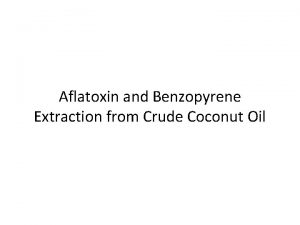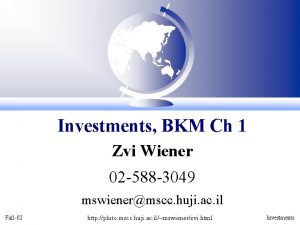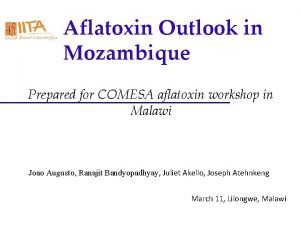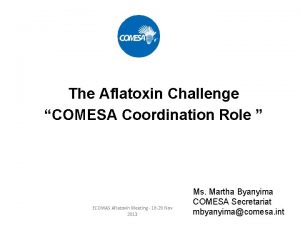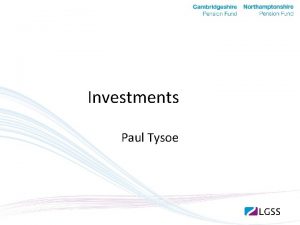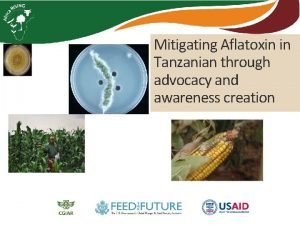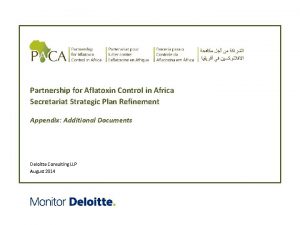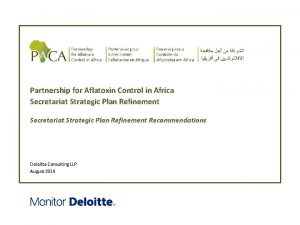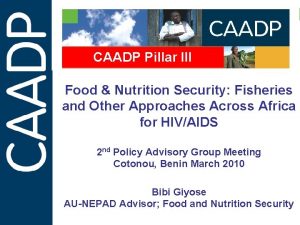INCREASING INVESTMENTS IN AFLATOXIN CONTROL THROUGH CAADP Regional











- Slides: 11

INCREASING INVESTMENTS IN AFLATOXIN CONTROL THROUGH CAADP Regional Workshop on the Aflatoxin Challenge in Eastern and Southern Africa 11 th-13 th March, 2014, Lilongwe, Malawi Dr. Sam Kanyarukiga Senior Agricultural Advisor Dr. Ken Shawa Policy Analyst

PRESENTATION OUTLINE I. III. IV. V. BACKGROUND CAADP PILLARS CAADP PROCESS-BENCHMARKS POINT OF ENTRY FOR AFLATOXIN CONTROL COMESA INTERVENTIONS

CAADP - BACKGROUND I. Endorsed at the Maputo Assembly of HOSG of the AU in 2003 II. Potential driver for economic growth and poverty reduction III. Encourages annual budgetary allocation of 10% to agric. IV. Targeted expenditure must enable at least 6% annual sectoral growth

CAADP - PILLARS 6 % ANNUAL SECTOR GROWTH 10% Budgetary Allocation Sustainable Land Water Management Infrastruct ure Trade and Market Access Food Nutrition and Livelihoods Ag. Research and Technology Adoption

CAADP Process – Benchmarks (1) 1. COMPACT Signature Rwanda, Ethiopia, Uganda, Kenya, DRC, Djibouti, Sudan, Burundi, Swaziland, Malawi, Zambia, Seychelles, Madagascar, Zimbabwe 2. Post COMPACT Process a) Design of NAIPS Rwanda, Uganda, Kenya, Ethiopia, Djibouti* DRC, Burundi, Malawi, Zambia, Zimbabwe (Technical Review) b) High-Level Business Meeting Rwanda, Uganda, Kenya, Ethiopia, DRC, Burundi, Malawi, Zambia.

CAADP Process – Benchmarks (2) 3. Regional Level Process ü Regional COMPACT endorsed ü Priority Areas Identified ü Program Design

POINT OF ENTRY FOR AFLATOXIN CONTROL (1) I. Stock-Taking Level ü Identify Level of Understanding and Gaps with regard to Food Safety and Aflatoxin. ü Identify existing Interventions (past and present) in Agricultural Sector Across Value Chains regarding Aflatoxin Issues. ü Quantify the adverse effects of Aflatoxin at Macroeconomic Level on Agriculture, Health and Trade.

POINT OF ENTRY FOR AFLATOXIN CONTROL (2) II COMPACT Development Level ü At the Objective Definition of the Agricultural Sector Development Strategy Issues of Food Safety, Food Security; Aflatoxin be clearly articulated. ü In the priority areas identified, and interventions developed, Issues of Aflatoxin be significantly Considered. ü That the different stakeholders, public sector, private sector, developing partners, civil society etc show commitment to engage in Aflatoxin related areas including commitment of resources and active participation in implementing M&E of the activities.

POINT OF ENTRY FOR AFLATOXIN CONTROL (3) III NAIP Development Level ü Developed NAIPS show in priority areas interventions/programs addressing aflatoxin issues and capacity building ü The Cross-Sectoral Nature of Aflatoxins should be taken into account (trade, health, etc) IV. AFLATOXIN Mainstreaming (e. g. Nutrition, Climate Smart Agriculture)

COMESA INTERVENTIONS At Regional Level ü Currently Developing Regional Investment Programs such as one on the “Promotion of Plant and Animal Health including Pest Control in Preand Post- Harvest Management” ü Workshop on PHL and Subsequent Country Road Maps-Countries urged to follow up on Aflatoxin

THANK YOU SO MUCH FOR LISTENING TO US
 Aflatoxin
Aflatoxin Luisa duque nude
Luisa duque nude Aflatoxin coconut oil
Aflatoxin coconut oil Britain diamond mining and increasing labour control
Britain diamond mining and increasing labour control Through one man sin entered
Through one man sin entered Classes of furcation
Classes of furcation Through and through sawing advantages
Through and through sawing advantages Nissim ezekiel poem night of the scorpion
Nissim ezekiel poem night of the scorpion Equity method vs cost method
Equity method vs cost method Real estate financial analysis
Real estate financial analysis Chapter 17 intermediate accounting
Chapter 17 intermediate accounting Investments bkm
Investments bkm


